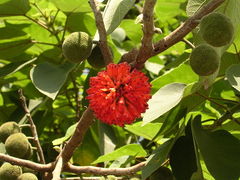Broussonetia papyrifera
| Broussonetia papyrifera subsp. var. | Paper Mulberry | |||||||||||||||||||||||||||||||||||||||||||||||||||||||
|---|---|---|---|---|---|---|---|---|---|---|---|---|---|---|---|---|---|---|---|---|---|---|---|---|---|---|---|---|---|---|---|---|---|---|---|---|---|---|---|---|---|---|---|---|---|---|---|---|---|---|---|---|---|---|---|---|

|
|
| ||||||||||||||||||||||||||||||||||||||||||||||||||||||
| ||||||||||||||||||||||||||||||||||||||||||||||||||||||||
The Paper Mulberry (Broussonetia papyrifera, syn. Morus papyrifera L.) is a tree in the family Moraceae, native to eastern Asia. Other names include Halibun, Kalivon, Kozo, and Tapacloth tree.
It is a deciduous tree growing to 15 m ft tall. The leaves are variable in shape (even on the same branch), unlobed ovate cordate to deeply lobed, with lobed leaves more frequent on fast-growing young plants; they are 7 - 20 cm long, with a rough surface above, fuzzy-downy below and a finely serrated margin. The male (staminate) flowers are produced in an oblong inflorescence, and the female (pistillate) flowers in a globular inflorescence. In summer, the pistillate flower matures into a red to orange, sweet, juicy fruit 3 - 4 cm diameter, which is an important food for wild animals. The fruit is edible and very sweet, but too fragile to be commercialized.
Problems: During the months of February until April proximity to this tree can contribute to severe pollen allergy. The fast growing Paper Mulberry when introduced to non-native areas can quickly disrupt the native habitat, becoming a highly invasive species and upsetting the natural ecosystem. When cut, the trees release a latex heavy sap which is extremely sticky. After chopping down a tree, it needs to be killed via herbicide or the root system will send out multiple coppices which grow quickly from the existing root system. The roots of the tree are aggressive enough to break cinder blocks and cause problems to drainage pipes.
| Standard Cyclopedia of Horticulture |
|---|
|
Broussonetia papyrifera, Vent. ( Morus papyrifera, Linn.). Tree, 30-50 ft., with thick, pubescent branches: Lvs. long- petioled, usually cordate-ovate, acuminate, coarsely dentate, often deeply lobed, especially on younger plants, rough above, pubescent beneath, 3-8 in. long: fr.-heads ¾in. across, red. May. China, Japan. Var. cucullata, Ser. (B. natricularis, Lodd.). Lvs. small, concave and curled upward. Var. laciniàta, Ser. (var. dissecta, Hort., var. Billárdii, Hemsl.). Lvs. finely dissected into very narrow lobes, often reduced to the nerves and only at the end with a small lanceolate or ovate-lanceolate 1ft.—Very distinct form, low and shrubby, more tender than the type. Var. macrophylla, Ser. Lvs. large, usually undivided. Var. leucocárpa, Xudib. Fr. white.
|
Cultivation
Propagation
Pests and diseases
Varieties
Gallery
-
Branch showing the leaves
-
Lobed leaves
-
photo 1
-
photo 2
-
Closeup of a leaf
References
- Standard Cyclopedia of Horticulture, by L. H. Bailey, MacMillan Co., 1963
External links
- w:Broussonetia papyrifera. Some of the material on this page may be from Wikipedia, under the Creative Commons license.
- Broussonetia papyrifera QR Code (Size 50, 100, 200, 500)



